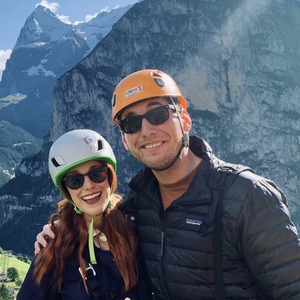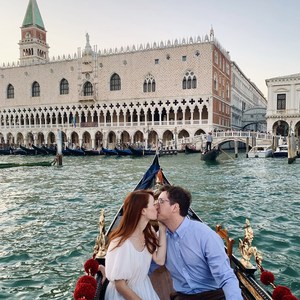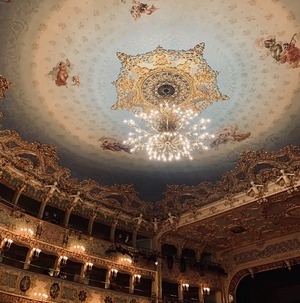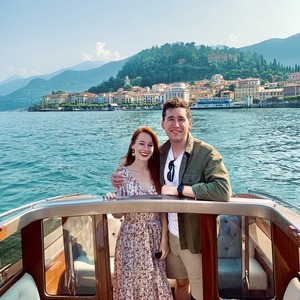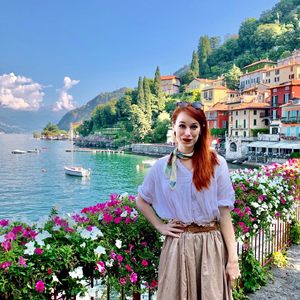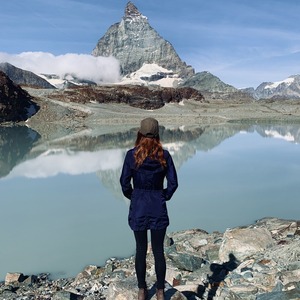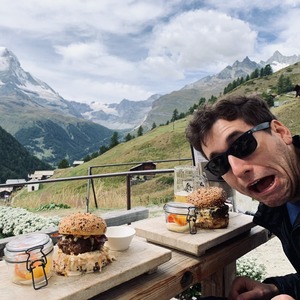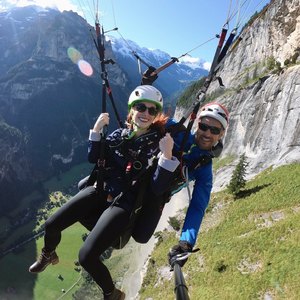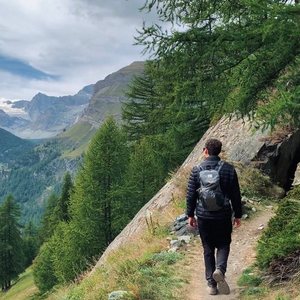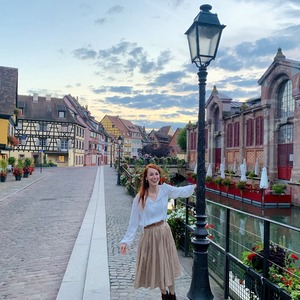Henry & Niki
For the first few mornings when we awoke to the bells of Piazza San Marco, it was difficult to tell if we were still dreaming.
On the balcony you could watch the sky lighten over the broad back of the Doge’s Palace. The slumbering canals, slowly crowding with vaporetti and striped-shirt gondoliers, gave avenue to a breeze that felt a lifetime clearer than the ashen haze that had characterized our wedding weekend.
We married in Tahoe during fire season. Standing at High Camp above Olympic Valley to photograph our first look, the plumes of the nearby forest blazes billowed like mushroom clouds. The sky miraculously cleared in the valley later that afternoon in time for our ceremony–outdoors in a birch-lined meadow–and we were blessed with both breathable air and well-diffused light. But the morning after on the drive through Donner Pass you could see once more the smoke clouds curling their fingers around the nearby peaks.
Yet what clouds there were in Venice held no smoke, only dreams. SFO had been nerve-wracking, flying overseas during Covid a new and unpleasant experience for us–a brief layover at Charles de Gaulle was barely enough time to scarf down sandwiches and double check our documents. Arriving in Venice felt like a literal breath of fresh air. Gliding past the tombs of San Michele, we relaxed our shoulders against the cream-colored cushions of the airport water taxi and happily allowed ourselves to be swallowed up by the floating city, a city that seemed to stand against time. We were so captivated by Venice that not even the tiredness of two international flights could keep us from exploring the piazza that first night after we had checked in our bags at the Hotel Danieli.
We fell in love, first with each other again as newlyweds, then with Venice and the European dream it promised. The jazz band outside Caffè Florian played “Blue Moon” the first morning as we drank stiff espresso out of delicate porcelain mugs, in dining rooms lavish enough to satisfy even the most extravagant doge.
My wife—calling her that still touched my tongue like sugar—wandered into a boutique and came out with a laced opera dress that looked dazzling that evening flowing across the carpeted stairs of Teatro La Fenice, where we saw a modernist performance of Rinaldo that had us both on our feet at the end. And afterwards, eating alleyway pizza on our balcony, still in our opera clothes, gazing up at the campanile that towered high into the sultry Venetian night while we listened to further Italian opera off a tinny phone speaker—you don’t often forget a moment like that.
Dawn came early the following morning for us, and we quickly found ourselves on a train bound for Milan. The countryside had not yet awoken by the time we had passed through it, finding ourselves now dwarfed by Milan’s enormous edifices. Those morning hours were filled with grandeur: criss-crossing beneath the glass-paneled roofs of the Galleria, wandering amongst the towering trunks of the stone forest inside and above the Duomo di Milano, gazing solemnly up at the image of Christ in Leonardo’s Last Supper in a darkened convent refectory. Not often are such small hours filled with such large things.
That afternoon we boarded a local train headed for the mountains of Lombardy. At Como we disembarked, awkwardly clattering our suitcases across the quiet cobblestone lanes that led down to the dock. Once there we found ourselves dazzled by the sparkling waters of that famous lake, heartachingly blue, as if competing—and winning—against the sky. Salvo the Best danced with abandon on the promenade, and we boarded the sweltering servizio rapido ferry to the sound of a one-man Euro-rave.
Bellagio was our destination, and for the next three days it was our corner of heaven on earth. Each morning we opened the shutters of our room to greet the lake and watch the little boats go by. The first morning we nabbed Prosecco from a convenience store and cruised around the lake in a riva with a friendly old man who declared himself to be our Italian father. From the water we saw the manicured sycamores, holm oaks, and Italian cypresses of Villa del Balbianello; the decadent gardens of the Villa Melzi, which we would explore later that afternoon; and the colorful facades and flowers of Varenna, which we would get to know the following day.
On our last night in the region we dressed up and snuck over to the opulent Serbelloni for late-night cocktails. Sitting in the evening room, we were the only ones listening to the good-natured piano player, who much to our astonishment played a rendition of “Blue Moon” that immediately solidified the song as the official soundtrack of our honeymoon. Afterwards we stole upstairs, found a quiet parlor, put “Blue Moon” on and held each other as we danced.
Our honeymoon-within-a-honeymoon at Lake Como ended the following morning. Narrowly making our connecting train after the early ferry was delayed by half an hour, we regained our composure back in Milan in time to confidently board the longer train that was to take us up into the Alps for the second major leg of our journey: Switzerland.
The mountains closed in around us, the air cooling considerably as we climbed. All along the spruce-lined valley, in the observation car filled with chattering American passengers, you could sense a rising anticipation. At the southern edge of the canton of Valais the Matterhorn beckoned, its pyramidic slopes rising into an obscurity of wispy white clouds.
From Zermatt station we were chauffeured through the winding streets in a tiny electric vehicle: you could not drive a car in Zermatt. This was the start of many good things. In our hotel room we were greeted with a bottle of chilled Veuve Clicquot and house-made chocolate truffles. From either of our two balconies you could gaze at the Matterhorn and at night with the window cracked and the curtains drawn slightly you could look out into the darkness and know that it was still there watching over you.
The Sunnegga funicular carried us towards the Rothorn the following morning and we hopped out at the first stop, descending a winding path towards the hamlet of Findeln which somehow clung to the grassy slope beneath it against all the wind howling down off the mountain. At Chez Vrony we were seated beside bushels of edelweiss on a fur-lined reclining bench seat that afforded us an intimate view of the mythical mountain across the valley. Steins of house beer washed down the raclette-topped hamburgers that fueled us for the lengthy walk back down to the village, through woods and across small clear streams that gave themselves over to waterfalls tumbling down to the forest floor. We tumbled after.
The next day we rode a cable car up to Trockener Steg and set foot on what we were sure must be the moon. Hiking beneath the Matterhorn on what was once glacier but was now shale and snow melt, at times we got so warm we stripped off our jackets and walked in t-shirts with our faces turned towards the sun. Then the wind would return and we would suit back up, laughing as we strolled across an alien planet, hearts pounding as we climbed our way out of gullies and carefully picked our path along winding, rocky trails. Reaching the Schwarzsee was a relief. On the way down the mountain we stopped in Furi for some more beer and warm fondue. It was refreshing and it was worth the toil.
One valley gave way to the next, and we soon found ourselves ambling over the cow trails and past the geranium-clustered balconies of beautiful Lauterbrunnen. We ate rosti and watched the cows pass by the towering Staubbach Falls, paying no attention to its towering magnificence. The Eiger, the Mönch, and the Jungfrau played out their colossal story high into the clouds above us, clouds that burst forth rain on our second day as we ascended the cable car with a paragliding flight crew.
One crew member kept checking a weather app on his phone and smiled confidently at us as he shouldered a bag two-times his size. It’ll pass in ten minutes, he told us, and when we reached the station at Mürren we sat and drank hot coffee while the storm raged everywhere, and the flight crew turned their noses up at the sky and back to their devices and sadly shook their heads. We agreed to try again tomorrow, and after they had left we figured we might as well make the most of things and see what the small towns up here had to offer. We stepped outside right as the last raindrop fell and the clouds parted in the valley below.
We didn’t mind the unfortunate timing. Setting out on a whim, we took the path to Gimmelwald and with each step felt like we were diving deeper into a storybook. Tractors passed by on the one-lane mountain road driven by old Swiss farmers with their tail-wagging passenger dogs. We met a few kittens outside an unmanned shop who, while shy, took the time to play with us and swipe at the string of my umbrella. All around us the clouds, empty now of rain, clung to the steep and densely-wooded mountains of the valley like a mist, and the jangle of cowbells in the hills rang out like Sunday morning. A few of those cows were kind enough to let us pet them as we walked through town; one returned the favor by snotting on my jacket sleeve. Cleaning up at the Pension Gimmelwald, we drank the darkest beer we had ever found, laughing as the cook tried to keep a stray cat out of the kitchen, and relaxed facing the towering mountains across the valley renewed by the rain.
The next morning was all sunlight and suspense. On a grassy slope above the cable car station in Mürren, we suited up and soared at last with our paragliding crew, blissfully gliding along the steep high wall of the valley. Once comfortable with the surreal feeling of soaring like a bird through the air, we spun daringly around in swirling corkscrew loops, descending like water down the drain towards a field still wet with morning dew.
From the valley floor my wife and I ascended once more, this time on a train headed up to Kleine Scheidegg, where, surrounded by marathon runners concluding their awe-inspiring trek up from Interlaken, we wolfed down bratwurst and boarded our connecting train to the very top of Europe, the Jungfraujoch. Far higher now than even the paragliders had taken us, we stepped out into a world of rock and snow, a world of slowly-retreating glaciers, of frigid ice tunnels with delicate sculptures somehow carved straight into the walls. Then, out on a frozen plateau, surrounded by other light-headed, giddy tourists, we engaged in a culminating act to kiss off the end of our Swiss journey: a snowball fight at the top of the world.
Down then into the fertile planes of the Alsace, east of the Vosges, west of the Rhine. Deep into the Alsatian lowlands we came at last to Colmar, the single most picturesque town we had ever set foot in—visual inspiration, in fact, for one of our favorite movies, Howl’s Moving Castle. Flammekueche, kugelhupf, and even escargot delighted our senses; in a corner of Maison Pfister a friendly shopkeeper treated us to schnapps and whiskey and many potent drinks. We spoke no other common language. The ornamentally-decorated Maison des Têtes, our hotel for the two-night stay, served the most exquisite breakfast either of us had ever known: thick sweet bread, soft scrambled eggs, local yogurt topped with fresh granola, and coffee to spin your head around. Swans swam up to greet us as we dined by the river on our last evening in town. The colors of the sky could almost number the colors of the buildings that decorated that perfect town.
Early the following morning we packed our bags and rolled through town towards the train station, once again dragging our suitcases behind us like mobile alarm clocks across the hard cobblestones. We were headed to Germany to be explorers of the Black Forest. At Freiburg im Breisgau we strolled through the brightly-colored stalls of the farmers market in the Münsterplatz while grim organ music piped out of the enormous doors of the towering gothic cathedral. We riffled through old books beneath the red arches of the Historisches Kaufhaus, divining each tome’s contents by cover alone.
We decided to play naughty and bought pumpkin spice lattes from a Starbucks on the other side of the Martinstor. It was now the middle of September and whispers of fall were blowing in from the dark curtain of der Schwarzwald, which rose up sharply on the hills behind the city. The romance of Italy was far behind us; now was the time for fairytales, for deep woods, for cool northern breezes and the fluttering of crisp leaves.
I gripped the wheel of our rental car tightly as we veered off into the forest, suddenly finding ourselves maneuvering densely-vegetated switchbacks that all but required a quick prayer before rounding. We parked at the Hexenlochmühle, the witch’s mill, a darkly-slated, double-wheeled water mill that served bratwurst and beer to weary travelers such as ourselves. In Triberg we met with a master cuckoo clockmaker and picked out a clock for our apartment back home. It was decorated in carved edelweiss that reminded us of Switzerland.
We passed through Wolfach, took a detour to explore the brightly-painted houses of Schiltach, double backed and passed north through Oberwolfach, and soon found ourselves cruising along der Schwarzwaldhochstraße, the high road, weaving through the pines and down sharp steep slopes. At last we made it, moments before the sun set, to the small town of Gernsbach, where we pulled into Schloss Eberstein—the castle in which we were to spend the night.
Tiny pumpkins adorned the entryway, and my wife fell onto the plush comforter of our four-post bed with all the giddiness of an American living out a true European fairytale. In the castle square stood a black cart filled with hay bales, miniature scarecrows, flowers and multi-colored gourds. Ivy dripped from the tower, and the view of the estate’s hillside vineyard came coupled with a panorama of the Murg valley below. We dined on the tree-lined terrace by candlelight, a four-course meal with enough house wine to have us both stumbling back up the medieval steps to collapse in our moon-drenched room.
The next morning arrived with a light rain. By the time we reached Baden-Baden we were in dire need of warmth to dry our bones. We found this at a Bavarian-style biergarten, where we ate further brats and drank taller steins. The grandeur of that Belle Epoque spa town still shined through the grayness of the morning. We avoided the buses on Leopoldsplatz and walked arm-in-arm along the Kaiserallee.
After filling up on Black Forest cake and coffee in a ritzy café, we hit the Autobahn and careened towards Heidelberg, our last stop in Germany. We dropped off the rental car and strolled back along the river to our hotel, which lay opposite the Altstadt across the Neckar. For three days and nights we explored that university town, reminiscing about our own time in college, back in Chicago where we first met. We strode up the meditative paths of der Philosophenweg, where near the top of the Heiligenberg we stopped for strudel and beers at an empty biergarten dappled in late-afternoon light. The friendly staff gave us blankets to drape over our shoulders, and we rested beside the buzzing tall grass.
On our last day we took the funicular up to the old schloss, grand even in ruins, and gazed at a wine tun the size of Noah’s ark. Thirsty, we sipped rieslings at the elegant Weißer Bock as we toasted to our last night on mainland Europe.
Time was growing short. One more destination lay ahead of us: an extended layover in Dublin, which gave us roughly twenty-four hours to make the most of the city. We would make them the longest twenty-four hours we could.
Centuries of history sped past us as we crossed the Liffey and stepped out in front of the posh Westbury hotel, near Grafton Street. Slinging our bags into our room, we sprinted out to drink pints and Irish coffee at the Hairy Lemon, buy sweaters at the Aran Sweater Market, and browse the books at Hodges Figgis. We had tickets to view the ancient Book of Kells at Trinity College at three-thirty. Dressed in our new Irish sweaters and carrying bags of treasured books, we admired the illuminated manuscript—what pages we were allowed to be shone—and the dark and dusty Long Room, which inspired us both.
For dinner we dined in a cramped, quaint corner of the Brazen Head, munching on bangers and mash and washing them down with cold, stout Guinness and nose-reddening shots of Red Breast. In the gloaming we walked slowly back to our hotel through crowds of hollering teenagers, crossed south over Ha’penny Bridge and grabbed brown bread ice cream at Murphy’s. We went to bed early and fell asleep to the sounds of revelry in the streets below.
And like that, it was over. Italy, Switzerland, France, Germany, and now Ireland receded into the past as we boarded the long flight home, heads resting against each other as we sat in disbelief that we had actually pulled the whole thing off. The honeymoon was over. But we had one last stop to make before returning home. Our flight descended, after an on-and-off sleep, into Chicago, the city where we first met and fell in love. We held hands beneath the glowing neon lights of the tunnel that lead to our connecting terminal, happy that the last stop of our honeymoon was the city where our love first flourished. It seemed like a fitting end, but it was only a beginning.
Without Traveler’s Joy, the trip we took would not have been possible. We know the memories of this adventure will last far longer than a new toaster or hand towels. We received just north of $8,000 on our registry, which went a long way towards helping pay for the hotels, train rides, meals, and champagne–so much champagne.
It goes without saying, despite all that has just been said, that we highly recommend Traveler’s Joy to help make your honeymoon a story worth telling.


